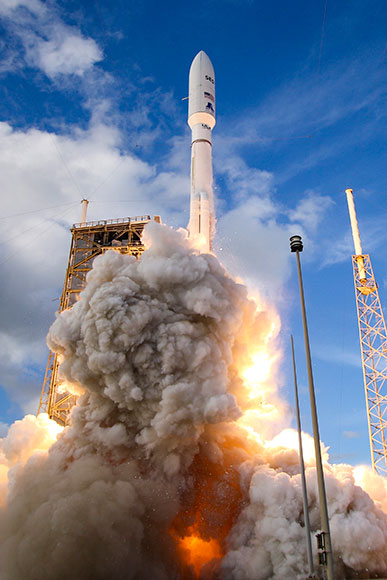
The Centaur upper stage of the United Launch Alliance Atlas V rocket is powered by an Aerojet Rocketdyne RL10 engine and 12 MR-106 reaction control system thrusters. (Photo credit: ULA)
October 4, 2022 – A United Launch Alliance (ULA) Atlas V rocket successfully delivered two commercial satellites to orbit today thanks in part to propulsion systems and tanks provided by Aerojet Rocketdyne. The satellites, known as SES-20 and SES-21, will operate over the continental United States to deliver C-band broadcast and radio services as well as critical data network services. The mission was launched from Space Launch Complex-41 at Cape Canaveral Space Force Station, Florida.
“Delivering these satellites safely to orbit is a key step in meeting the objectives of the Federal Communications Commission’s 5G Fast initiative, which requires satellite operators to clear a portion of C-band spectrum to make way for 5G mobile services.” said Aerojet Rocketdyne’s Space Business Unit Senior Vice President Jim Maser. “While it isn’t often that our company plays a role in expanding infrastructure here on Earth, it is great to be a part of the team that is helping to make way for 5G mobile services across the country.”
The Atlas V’s Centaur upper stage was powered by Aerojet Rocketdyne’s RL10C-1-1 engine, which generated 23,825 pounds of thrust to help deliver both spacecraft into their intended orbits. A complement of 12 Aerojet Rocketdyne MR-106 reaction control system thrusters helped steer Centaur by providing roll, pitch and yaw control. These monopropellant rocket engines each generate 5-10 pounds of thrust. The RL10 engine was built at Aerojet Rocketdyne’s West Palm Beach, Fl. facility, and the MR-106 thrusters were built in Redmond, Washington.
Six composite overwrapped pressure vessels (COPVs) built by Aerojet Rocketdyne subsidiary ARDÉ supported operation of the Atlas V. These tanks, four on the first stage and two on the second stage, hold helium at high pressure that is used to help deliver propellants to the Atlas V and Centaur engines.

